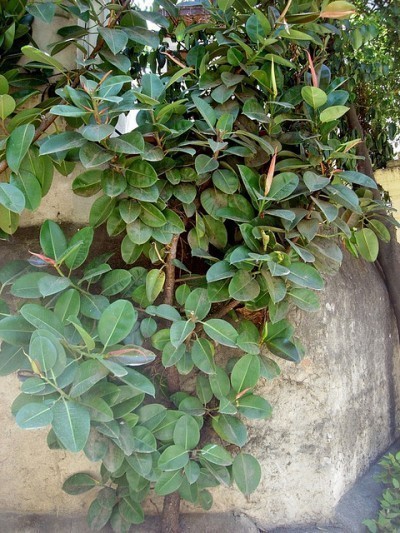






The rubber tree is a large houseplant and most people find it is easy to grow and care for indoors. However, some people ask about growing outdoor rubber tree plants. In fact, in some areas, this plant is used as a screen or patio plant. So, can you grow rubber plant outside? Read more to learn about taking care of a rubber plant outside in your area.
Gardeners in USDA Hardiness Zones 10 and 11 can grow the plant outdoors, according to most rubber plant information. Outdoor rubber tree plants (Ficus elastica) may grow in Zone 9 if winter protection is offered. In this area, outdoor rubber tree plants should be planted on the north or east side of a building for protection from the wind. When the plant is young, prune it to a single trunk, as these plants tend to split when caught in the wind.
Rubber plant information also says to plant the tree in a shady area, although some plants accept light, dappled shade. Thick, glabrous leaves burn easily when exposed to sunlight. Those living in tropical zones outside of the United States can grow outdoor rubber tree plants easily, as this is their native environment.
In the wild, outdoor rubber tree plants can reach 40 to 100 feet in height. When using this plant as an outdoor ornamental, pruning limbs and the top of the plant make it sturdier and more compact.
If you live in a more northern area and want to grow outdoor rubber tree plants, plant them in a container. Taking care of a rubber plant growing in a container can include locating them outdoors during seasons of warm temperatures. Optimum temperatures for taking care of a rubber plant outdoors are 65 to 80 F. (18-27 C.) Outdoors, plants acclimated to cooler temperatures should be brought indoors before temperatures reach 30 F. (-1 C.).
Rubber plant information suggests plants require deep watering and then allow the soil to dry out almost completely. Some sources say containerized plants should be allowed to dry out completely between waterings. Still other sources say the drying of the soil causes leaves to drop. Keep an eye on your rubber tree growing outdoors and use good judgment on watering, depending on its location.
Fertilize the outdoor rubber tree with a food for acid-loving plants, such as those for azaleas.
Copyright © www.100flowers.win Botanic Garden All Rights Reserved